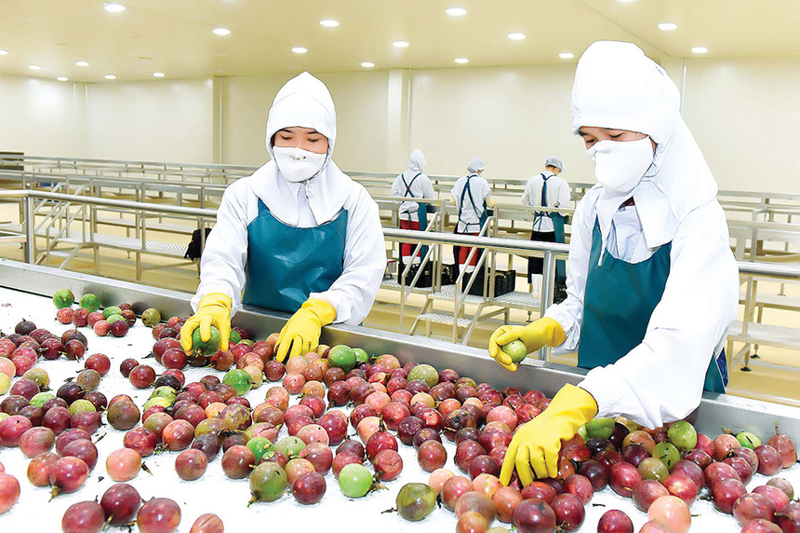
According to the Vietnamese Trade Office in Canada, Canada’s fruit import market reached approximately 6 billion USD in 2024. From 2019 to 2024, Vietnam ranked 9th among the top ten exporters of fruit and nut products to Canada. Vietnam’s competitors beyond the United States and Mexico included Peru, Guatemala, Chile, South Africa, Costa Rica, Morocco, and Turkey.
• DRAGON FRUIT, LEMONS, POMELOS… VIETNAM HOLDS A LARGE SHARE
In 2024, Vietnam exported around 120 million USD worth of fruit and nut products to Canada, with cashew nuts alone accounting for 65 percent (78 million USD). Including cashews, exports to Canada grew modestly by 24 percent since CPTPP.
Excluding cashews, fresh fruit exports from Vietnam rose by 207 percent post‑CPTPP, reaching 41.7 million USD in 2024.
Vietnam remained the largest exporter of dragon fruit, lemons, pomelos, fresh coconuts, and more recently guava, mango, longan, durian, and fresh lychee, with no strong competitors. Lemon and pomelo exports grew the fastest (483 percent) after CPTPP, making them among the top three fruit export categories, behind only dragon fruit.
Fresh durian grew nearly 1900 percent after CPTPP, achieving export value of 3.65 million USD in 2024. Fresh coconuts increased by 196 percent post‑CPTPP, with Vietnam overtaking Thailand to become the second‑largest coconut exporter to Canada after India in 2024. Coconut exports are projected to reach 1 million USD in 2025.
Vietnam’s U Hoang lychee has appeared in several Asian supermarket chains and Costco, boosting product recognition.
Nevertheless, competition is emerging in dragon fruit, soursop, and passion fruit from Brazil. Colombia and Mexico have also begun growing durian, lychee, and rambutan. Tropical fruit products from Latin America are perceived to offer much better quality and pricing than their Vietnamese counterparts.
Vietnam faces weaknesses in unstable supply and price fluctuations, high logistics costs. Vietnamese produce also competes strongly with Chinese traders, who currently control many supermarket chains and prefer sourcing from China.
Moreover, Vietnam has yet to preserve and develop traditional fruit varieties or new cultivars favored by the market.
The network of collectors and traders remains under‑developed, while farmers often chase profits without attention to standards.
• STRICT COMPLIANCE WITH QUALITY REQUIREMENTS
According to Trần Thu Quỳnh, Trade Counselor at the Vietnamese Trade Office in Canada, Canada’s fruit and vegetable market is generally accessible. Canada does not require bilateral market access negotiations per product, nor protocols or export licenses for regular exports, nor growing‑area codes.
Canada imposes tariffs on only a few seasonal domestic products for domestic protection, which Vietnam lacks strength in.
In other words, “even without the CPTPP, fresh fruit and vegetable exports from Vietnam are typically taxed at zero whether under CPTPP preferences, MFN (most‑favored nation), or GPT (general preferential tariff)” .
However, Canada adheres to WTO rules on plant and animal health sanitation and quarantine. It maintains strict standards on product quality, size, weight, ripeness, packaging, labeling, hygiene, pesticide or additive residues, and food safety.
Organic products require certification aligning with Canada’s organic standards. A plant‑quarantine certificate under Canada’s Plant Protection Act is necessary. Canada bans treatment with sulphites (except for grapes) and prohibits imports contaminated with pathogens like coliforms, E. coli, or salmonella.
Moreover, imports must comply with labeling and advertising guidelines of the Canadian Food Inspection Agency, including bilingual information. Fresh fruits and vegetables are exempt from nutritional labeling, but frozen, dried, or canned products must include it.
To access the Canadian market, Ms. Quỳnh recommends businesses develop websites and complete production and quality certifications (GlobalGAP, GMP, HACCP). They should publicly present facilities, warehouses, workforce, and product images.
Focus on products with fewer rivals such as specialty herbs and vegetables. Be transparent about CSR (corporate social responsibility) practices. Use e‑commerce and digital marketing to reach customers effectively.
Canada encourages providing processing details or recipe suggestions for specialty products. Canadian consumers pay attention to packaging and preservation methods (vacuum sealing, recyclable materials…).
Requirements vary for each fruit: for example, avocados packed in cartons of one tray (14–20 fruits, 6 kg) or two trays (28–40 fruits, 12 kg); guavas in 2‑kg cartons; mangoes packed 9–12 per carton weighing ~4.5 kg.
Source: vneconomy.vn




